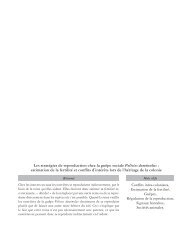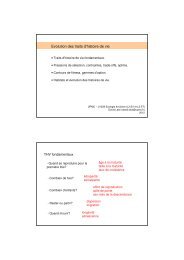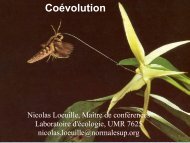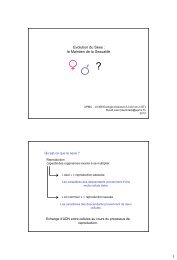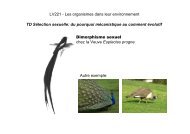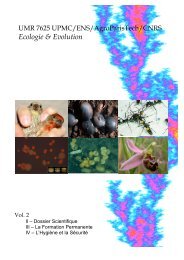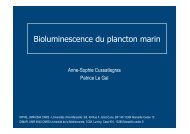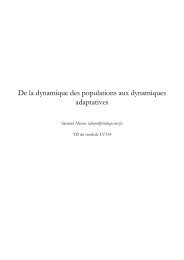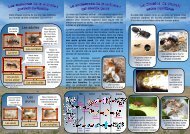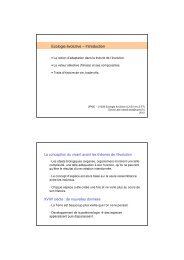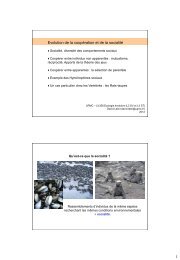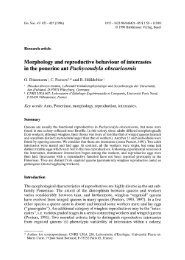rapport d'auto-Žvaluation - Ecologie & Evolution - Université Pierre ...
rapport d'auto-Žvaluation - Ecologie & Evolution - Université Pierre ...
rapport d'auto-Žvaluation - Ecologie & Evolution - Université Pierre ...
You also want an ePaper? Increase the reach of your titles
YUMPU automatically turns print PDFs into web optimized ePapers that Google loves.
22. Hanus R., Šobotník J., Krasulová J., Jiroš P., Žáček P., Kalinová B., Dolejšová J., Cvačka J.,<br />
Bourguignon T., Roisin Y., Lacey M., Sillam-Dussès D., (2012) Nonadecadienone, a new termite<br />
trail-following pheromone identified in Glossotermes oculatus (Serritermitidae). Chemical Senses<br />
37, 55-63<br />
23. Helft F., Tirard C., Doums C., (2012) The effects of division of labour on phenoloxidase based<br />
immunity in workers of the ant Cataglyphis cursor. Insectes Sociaux, 59, 333-340<br />
24. Hora R.R., Poteaux C., Doums C., Fresneau D., Fénéron R., (2007) Egg cannibalism in a<br />
facultative polygynous ant: conflict for reproduction or strategy to survive? Ethology, 113, 909-<br />
916<br />
25. Krasulová J., Hanus R., Kutalová K., Šobotník J., Sillam-Dussès D., Tichý M., Valterová I., (2012)<br />
Chemistry and anatomy of the frontal gland in soldiers of the sand termite Psammotermes<br />
hybostoma (Rhinotermitidae). Journal of Chemical Ecology 38, 557-565<br />
26. Lacey M., Sémon E., Krasulová J., Sillam-Dussès D., Robert A., Cornette R., Hoskovec M., Žáček<br />
P., Valterová I., Bordereau C., (2011) Chemical communication in termites: syn-4,6dimethylundecan-1-ol<br />
as trail-following pheromone, syn-4,6-dimethylundecanal and (5E)-2,6,10trimethylundeca-5,9-dienal<br />
as the respective male and female sex pheromones in Hodotermopsis<br />
sjoestedti (Isoptera, Archotermopsidae). Journal of Insect Physiology 57, 1585-1591<br />
27. Molet M., Chittka L., Raine N.E., (2009) Potential application of the bumblebee foraging<br />
recruitment pheromone for commercial greenhouse pollination. Apidologie, 40, 608-616<br />
28. Molet M., Chittka L., Raine N.E., (2009) How floral odours are learned inside the bumblebee<br />
(Bombus terrestris) nest. Naturwissenschaften, 96, 213-219<br />
29. Molet M., Chittka L., Stelzer R.J., Streit S., Raine N.E., (2008) Colony nutritional status<br />
modulates worker responses to foraging recruitment pheromone in the bumblebee Bombus<br />
terrestris. Behavioral Ecology and Sociobiology, 62, 1119-1126<br />
30. Molet M., Peeters C., Follin I., Fisher B.L., (2007) Reproductive caste performs intranidal tasks<br />
instead of workers in the ant Mystrium oberthueri. Ethology, 113, 721-729<br />
31. Molet M., Peeters C., Fisher B.L., (2007) Permanent loss of wings in queens of the ant<br />
Odontomachus coquereli from Madagascar. Insectes Sociaux, 54, 174-182<br />
32. Molet M., Peeters C., Fisher B.L., (2007) Winged queens replaced by reproductives smaller than<br />
workers in Mystrium ants. Naturwissenschaften, 94, 280-287<br />
33. Molet M., Van Baalen M., Peeters C., (2008) Shift in colonial reproductive strategy associated with<br />
a tropical-temperate gradient in Rhytidoponera ants. The American Naturalist, 172, 75-87<br />
34. Molet M., Fisher B.L., Ito F., Peeters C., (2009) Shift from independent to dependent colony<br />
foundation and evolution of ‘multi-purpose’ ergatoid queens in Mystrium ants (subfamily<br />
Amblyoponinae). Biological Journal of the Linnean Society, 98, 198-207<br />
35. Molet M., Wheeler D., Peeters C., (2012) <strong>Evolution</strong> of novel mosaic castes in ants: Modularity,<br />
phenotypic plasticity, and colonial buffering. The American Naturalist, 180, 328-341<br />
36. Monnin T., Cini A., Lecat V., Fédérici P., Doums C., (2009) No actual conflict over colony<br />
inheritance despite high potential conflict in the social wasp Polistes dominulus. Proceedings of<br />
the Royal Society, Series B, 276, 1593-1601<br />
37. Monnin T., Liebig J., (2008) Understanding eusociality requires both proximate and ultimate<br />
thinking and due consideration of individual and colony-level interests. Oikos, 117, 1441-1443<br />
38. Monnin T., Peeters C., (2008) How many gamergates is an ant queen worth? Naturwissenschaften,<br />
95, 109-116<br />
39. Peeters, C., (2012) Convergent evolution of wingless reproductives across all subfamilies of ants,<br />
and sporadic loss of winged queens (Hymenoptera: Formicidae). Myrmecol. News 16, 75-91.<br />
40. Peeters, C., Keller R.A., Johnson R.A., (2012) Selection against aerial dispersal in ants: Two nonflying<br />
queen phenotypes in Pogonomyrmex laticeps. PLoS One<br />
41. Peeters C., Molet M., (2010) <strong>Evolution</strong> of advanced social traits in phylogenetically basal ants:<br />
striking worker polymorphism and large queens in Amblyopone australis. Insectes Sociaux, 57,<br />
177-183<br />
42. Sillam-Dussès D., Forschler B.T., (2010) A dominant and undescribed species of Reticulitermes in<br />
Sapelo Island (Georgia, USA). Sociobiology 56, 137-147<br />
43. Sillam-Dussès D., Šobotník J., Abd El-Latif A.O., Jiroš P., Kalinová B., Krasulová J., Cvačka J.,<br />
Valterová I., Hanus R., (2011) Sex pheromone and trail pheromone of the sand termite<br />
Psammotermes hybostoma (Rhinotermitidae: Psammotermitinae) from Sahara. Journal of<br />
Chemical Ecology 37, 179-188<br />
44. Sillam-Dussès D., Sémon E., Robert A., Cancello E.M., Lenz M.J., Valterová I., Bordereau C.,<br />
(2010) Identification of multi-component trail pheromones in the most evolutionarily derived<br />
termites, the Nasutitermitinae (Termitidae). Biological Journal of the Linnean Society 99, 20-27<br />
118



